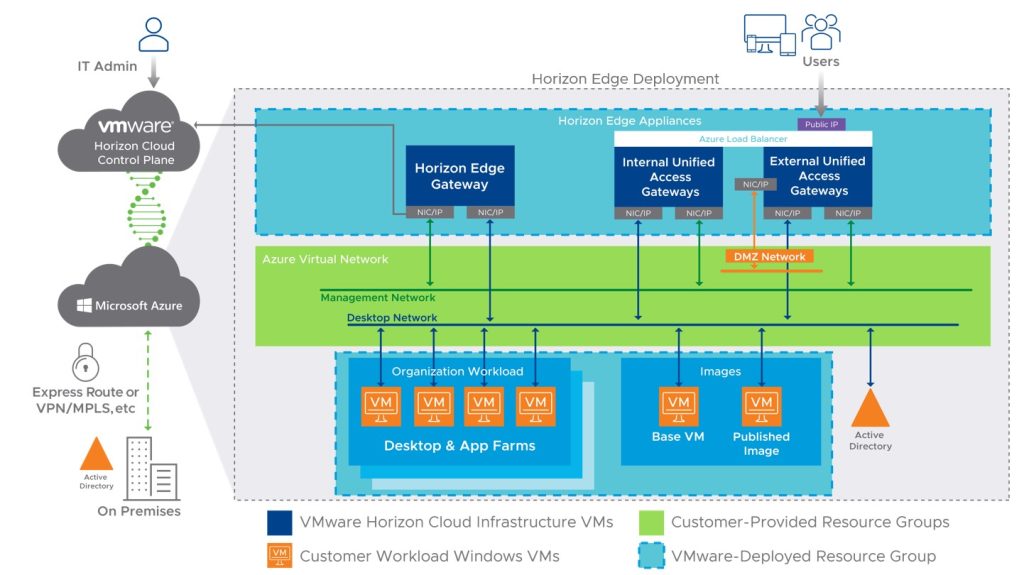In this series, Ron Oglesby will be breaking down the most important new features of our next-gen Horizon Cloud services. These features will not only “fill the gaps” that customers have often seen between on-premises and cloud desktop technologies, but will also give customers more flexibility and new options and tools for managing their virtual desktop environments.
Last year at VMworld we announced that we were developing the VMware Horizon next-generation hybrid DaaS architecture. After several months of limited availability, this year we were able to announce General Availability of this new service to all Horizon Cloud environments on Microsoft Azure.
It should be noted that while Azure is our first platform release, this service has been designed from the ground up to support multiple cloud/hyperscaler environments and even your existing on-prem virtual desktop implementations.
Over the past decade I have watched as various vendors (including VMware) tried to port existing technology and services into cloud environments. Everyone tried to rush to the cloud, knowing that cloud hosting all the services and technology required for virtual desktop environments was the future. But like many technologies that were rushed in this way, the initial releases of these “ported” technologies into the cloud meant that customers had to make a decision. If they wanted the benefits of cloud (less infrastructure on premises, more scalability, faster updates, better monitoring, and more), would it be worth giving up several existing features and functionality from their existing on-prem solutions? It was not a great choice for customers or vendors to have to make.
The future of virtual desktops is in the cloud … not in your data center
Our EUC CTO, Shawn Bass, once made a comment about Windows that is still stuck in my head: “Even after a nuclear war, the only things left will be cockroaches and Windows apps.”
Now — over a decade later — mobile devices, tablets, and Macs are all over the place. Yet, as predicted, organizations still rely on many Windows apps. So, organizations require a way to host and deliver all these apps. As we know, the solution is desktop virtualization, and the future of virtual desktops is in the cloud.

The reality of cloud-hosted desktop infrastructure allows for numerous benefits that will continue to expand as the service matures. The most important to me are the collection and analysis of desktop, application, and network data. When paired with cloud-based machine learning this data can be used not just for reporting on performance but also for Guided Root Cause Analysis of failures, predicting failures and suggesting preemptive solutions, and of course intelligently managing the configuration and power usage in the environment (read, cost savings).
The power of these technologies to reduce the workload of the IT staff and reduce costs while improving user experience cannot be overstated. And the key thing about having this intelligent back end is that it will use vast amounts of data from contributing users, which will allow failures to be spotted early. More important, the characteristics and solutions will be documented and distributed to other users instantly. Today that type of analysis and remediation is done manually. It requires people to comb through logs, research and test, and sometimes just hope that someone else has seen this issue before and can provide a fix.
Of course, the great thing about having the infrastructure moved into the cloud, with desktops and applications being able to live anywhere (on premises or multiple vendor clouds), is that you get to focus on the most important thing, your applications and the users’ experience with these applications.
Over the coming weeks I will write blogs on the many features found in this new architecture. Some of the topics will include:
- Horizon Cloud next-gen is API driven
- Increased scalability (no more Pods!)
- The Horizon thin-edge architecture
- DaaS for customers and partners
If you haven’t heard about Horizon Cloud next-gen it is important to understand that this is a new design and implementation specifically designed for hybrid and multi-cloud environments. This is the future of Horizon, and it’s time to take a deeper look at it. Here are a couple of resources:
For the initial release blog, check out this article: “The Next Generation of VMware Horizon Cloud Is Here!”
Or, to see the requirements and deployment steps, check out our documentation in Tech Zone.
For a comprehensive overview of the most important features of Horizon Cloud next-gen, we encourage you to read all of the blogs in this series:
How Horizon Cloud Next-Gen Reduces Costs and Increases Scalability
API First! A Look at the Most Important Features of Horizon Cloud Next-Gen
Thin Edge! A Look at the Most Important Features of Horizon Cloud Next-Gen











